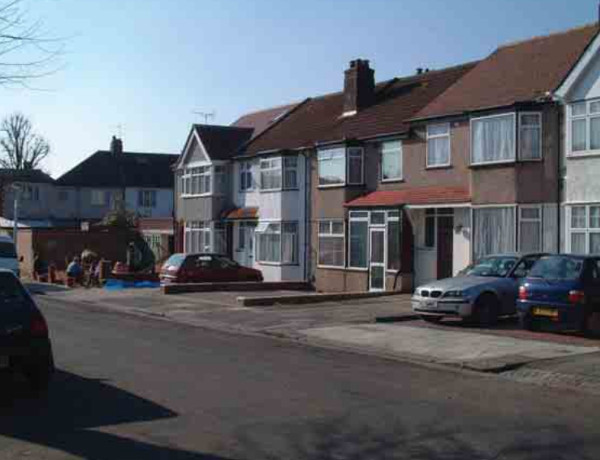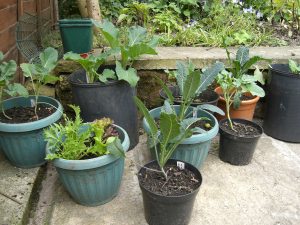The RHS 2015 Greening Grey Britain Report reveals that three times as many front gardens are paved over compared to ten years ago, a total increase of 15 square miles of ‘grey’, and that plant cover in front gardens has decreased by as much as 15%.
Over five million front gardens now have no plants growing in them, 7.24 million are nearly totally paved over and four and a half million front gardens are completely paved over. Today one in four UK front gardens are completely paved over and nearly one in three front gardens has no plants. The RHS believes it is vital to reverse this trend for the nation’s health, for wildlife, to mitigate against pollution and heat waves and to protect the UK’s homes from flooding.
Sue Biggs, RHS Director General, explains: “There is a recognised critical need to increase green in our towns and cities by 10%1 to help combat predicted rises in temperature. The evidence in this report suggests we need to increase this target to deal with the 15% loss of greenery in front gardens. We need to urgently increase plants in urban environments, and better understand how to select and use ornamental plants, not reduce them, as this reports indicates we’re doing. Whatever the pressures to pave, there is always room for plants.
“Gardens are good for our towns and cities2,3. This reduction of plants in front gardens and increase in grey is harmful for wildlife, reducing their homes and food sources. It is also damaging for the nation’s health – linked to increasing pollution and increasing temperatures during heat waves and puts our homes at more risk from flooding.”
The RHS launched the Report at the RHS Chelsea Flower Show as part of its campaign to get Greening Grey Britain. The gardening charity is calling on people to pledge to green their own bit of grey and sharing updated advice and ideas to green up front gardens at www.rhs.org.uk/ggb. As part of the campaign, RHS Britain in Bloom is also transforming 6,000 community spaces from grey to green over the next three years. Key to the campaign is sharing ideas for parking and plants in front gardens.
Joe Swift, BBC presenter of the Chelsea Flower Show who has pledged to get Greening Grey Britain (rhs.org.uk/ggb), says; “We can all make our streets greener and better places to live and take action against this growing concrete jungle. We’ve made this conversion to grey one garden at a time and now, today, there are 7.24 million front gardens that are mostly paved. It’s time to get gardening; we can all make difference: from window boxes to tree planting, let’s join the RHS and get Greening Grey Britain.”
Sue finishes, “Our work to get Greening Grey Britain began in April with the 2015 launch of Europe’s biggest community gardening campaign, RHS Britain in Bloom with a three year target to transform 6,000 unloved grey spaces into thriving planted up places.
“Over the coming months we will continue to share and promote ideas for individuals and communities to go from grey to green, ranging from pulling up a paving stone and planting it up, to creating window box, planting up front gardens and transforming grey public spaces. Greening Grey Britain can be as big or small as anyone likes, the critical point is that collectively we can all make a positive difference one plant at a time.”
The worst place in the country for paving over front gardens is London, with half of all front gardens paved over and a 36% increase over the last ten years. London also had the biggest reduction of plant cover in front gardens in the UK, with five times as many front gardens with no plants compared to ten years ago. The North East is the only place in the UK that has reduced the number of completely paved gardens. Front gardens in the North East with 50% plants or more also increased by almost 30%.

RHS 5 top tips for squeezing plants into the front garden
-
Fill up the corners: you usually can’t park there so plant instead
-
Go up the wall: climbers and wall shrubs take up little space. And they don’t only look great, they’ll insulate your home too, saving on heating bills
-
Hedge your bets: Rather than walls or fences, grow a hedge to filter out particulate (dust) pollution to help you breath more easily. It will provide a home for wildlife too.
-
Growing up: With a slender trunk, a tree can take your greenery up and over the cars.
-
No soil? Plant in containers: Even 100% paved gardens can be made greener by using containers.
For more information, please contact Hayley Monckton in the RHS Press Office on 020 7821 3043 or email pressoffice@rhs.org.uk or hayleymonckton@rhs.org.uk
Mori Poll
2015 Mori Poll to 1,492 people in the UK aged 15+ with front gardens, Mar 6-22 2015
2005 Mori Poll to 1,723 people in the UK aged 15+ with front gardens, May 19-23 May
NB The figures provided are rounded to whole numbers. However, in some cases, this makes the totals add up to more or less than 100%. If you need figures with two decimal places to provide clarity, please contact the press office.
Q1
Roughly what percentage of your front garden is paved/concreted/gravelled over (e.g. for parking, patio etc.)?
|
2005 |
2015 |
|
|
0% |
18% |
9% |
|
1-24% |
13% |
25% |
|
25-49% |
11% |
13% |
|
50-74% |
27% |
15% |
|
75%-99% |
22% |
14% |
|
100% |
8% |
24% |
|
Don’t know |
1% |
0% |
-
The significant increase in 100% paved over gardens is the biggest concern
-
Three times as many front gardens are 100% paved over compared to ten years ago
-
Nearly one in four UK front gardens are completely paved over
-
Number of front gardens with no paving has halved over last ten years
-
Nearly 54% of the total surface area of front gardens is hard surfacing (grey)
-
The overall amount of reported paving has increased 3.6%; based on the average area of front gardens this is nearly 15 square miles nationally, in the last ten years
-
The most affected area: London with 46% gardens completely paved – and the biggest increase in completely paved gardens (36% rise). Followed by East and West Midland areas
Q2
Roughly what percentage of your front garden is green (grass, plants, bare earth etc.)?
|
2005 |
2015 |
|
|
0% |
8% |
28% |
|
1-24% |
17% |
16% |
|
25-49% |
15% |
12% |
|
50-74% |
24% |
20% |
|
75%-99% |
17% |
19% |
|
100% |
18% |
5% |
|
Don’t know |
1% |
0% |
-
Almost one in three front gardens in the UK today have no plants
-
Three and a half times as many front gardens have no plants compared to ten years ago
-
Planting has decreased 15% overall
Amount of paving
In 2005: 1.5 million front gardens completely paved (i.e 8%)
In 2015: 4.59 million front gardens completely paved (i.e. 24%)
Difference: rise of 3.09 million of gardens completely paved (i.e over 200% increase)
Amount of green
In 2005: 1.5 million front gardens have no plants (i.e 8%)
In 2015: 5.35 million front gardens have no plants (i.e. 28%)
Difference: rise of 3.85 million front gardens with no plants (i.e. over 250% decrease in amount of green)
Relevant facts:
-
Traditional, non-permeable paving in front gardens, such as asphalt, block paving and concrete often requires planning permission by law. However, what you can and can’t do varies between England, Scotland and Wales – see the Permeable Paving page on the RHS website for details.
-
Trees, hedges and climbers can reduce cost of heating and cooling. In particular, summer cooling saving have been estimated at around 30 percent4.
-
Garden plants and trees intercept intense rain, slowing run off and reducing pressure on drains especially during summer storms5.
-
In Leeds, there has been a 13% increase in impervious surfaces over the last 30 years, 75% of which was due to the paving of front gardens6.
-
45% of local authorities are considering either selling parks and green spaces, or transferring their management to others7.
-
10% increase in vegetation would help control the predicted climate change increases to summertime air temperatures1.
—————————————————————————————————————————
1 Gill SE, Handley JF, Ennos AR, Pauleit S (2007) Adapting cities for climate change: the role of green infrastructure. Built Environment 33: 115–133.
2 Blanusa, T., Page, A, et al (2011) Gardening Matters: Urban Gardens. Royal Horticultural Society, London p1-8. https://www.rhs.org.uk/Science-Environment/PDF/Climate-and-sustainability/Urban-greening/Gardening-matters-urban-greening.pdf
3Cameron, R., Blanusa, T., Taylor, J., Salisbury, A., Halstead, A., Henricot, B. and Thompson, K. (2012) The domestic garden: its contribution to urban green infrastructure. Urban Forestry and Urban Greening. http://centaur.reading.ac.uk/26212/
4 Akbari H, Kurn DM, Bretz SE, Hanford JW (1997) Peak power and cooling energy savings of shade trees. Energy and Buildings 25: 139–148.
5 Meerow AW, Black RJ (2003) Enviroscaping to conserve energy: a guide to microclimate modification. In: Circular EES-43. Florida Cooperative Extension Service, Institute of Food and Agricultural Sciences, University of Florida, Florida, USA, p10.
6 Perry T, Nawaz R (2008) An investigation into the extent and impacts of hard surfacing of domestic gardens in an area of Leeds, United Kingdom. Landscape and Urban Planning 86: 1–13.
7 (2014) The State of UK Public Parks 2014 – Renaissance to Risk?, Heritage Lottery Fund, London, p3
Other sources for comparison
-
85% of properties have a front garden, so 19.13 million*. 19.13 x 56 sq m = 1071 sq km or 413 sq miles. Average size of front garden 56 sq m+ or 7 x 8 m (were on average 7.2m deep*)
-
7 million front gardens paved**
-
Almost a third (30%) of front plots and 15% of rear plots, had the area largely or wholly covered by hard landscaping materials (concrete, paving, gravel, tarmac etc.)*
-
Wholly paved gardens rose to 48% for city and urban centres and 50% for dwellings built before 1919*
-
The presence of hard landscaped rear plots was strongly related to deprivation. Just 7% of dwellings in the least deprived areas had the rear plot largely or wholly hard landscaped, compared with 29% in the most deprived areas*
-
25% of garden space is front gardens+
-
All garden space accounts for approximately half the greenspace in towns and cities; or a fifth to a quarter of the land in towns and cities#
+ Smith, C (2010) “London: Garden city?” London Wildlife Trust, Greenspace Information for Greater London, Greater London Authority, London. http://www.lbp.org.uk/downloads/Publications/HabitatInfo/LondonGardenCity.pdf
*Office for National Statistics and Miller Mitchell Burley Lane (2010) “English Housing Survey Housing stock report 2008”, Department for Communities and Local Government https://www.gov.uk/government/uploads/system/uploads/attachment_data/file/6703/1750754.pdf
** Bates, J and Leibling (2012), D “Spaced Out Perspectives on parking policy”, RAC Foundation, http://www.racfoundation.org/assets/rac_foundation/content/downloadables/spaced_out-bates_leibling-jul12.pdf
# Cameron, R., Blanusa, T., Taylor, J., Salisbury, A., Halstead, A., Henricot, B. and Thompson, K. (2012) The domestic garden: its contribution to urban green infrastructure. Urban Forestry and Urban Greening. http://centaur.reading.ac.uk/26212/
About the RHS
The Royal Horticultural Society was founded in 1804 by Sir Joseph Banks and John Wedgwood for the encouragement and improvement of the science, art and practice of horticulture. We held our first flower shows in 1820, were granted a Royal Charter in 1861 and acquired RHS Garden Wisley, our flagship garden, in 1903. From our first meetings in a small room off London’s Piccadilly, we have grown to become the world’s largest gardening charity.
Today the RHS is committed to providing a voice for all gardeners. We are driven by a simple love of plants and a belief that gardeners make the world a better place. 210 years on we continue to safeguard and advance the science, art and practice of horticulture, creating displays that inspire people to garden. In all aspects of our work we help gardeners develop by sharing our knowledge of plants, gardens and the environment.
RHS membership is for anyone with an interest in gardening. Support the RHS and secure a healthy future for gardening. For more information call: 0845 130 4646, or visit www.rhs.org.uk/join
The RHS Lindley Library houses and cares for the finest collection of horticultural literature in the world, including a comprehensive collection of 19thc books on the ‘Language of Flowers’. Researchers can consult these books by appointment. For more information call: 0207 8213050 or visit http://www.rhs.org.uk/About-Us/RHS-Lindley-Library.
RHS Registered Charity No. 222879/SC038262









2 Comments
Or if you really have to have that parking space use something which is going to let the water drain through and not rush off into the street to help block drains that can’t cope with the extra water
I’d love to see an update on these figures for 2020. Locally I see an ever increasing number of front gardens 90-100% paved. The environmental impact is a concern plus it makes the neighbourhood look like a ‘concrete’ wasteland.